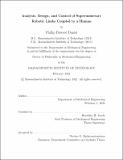Analysis, Design, and Control of Supernumerary Robotic Limbs Coupled to a Human
Author(s)
Daniel, Phillip Howard
DownloadThesis PDF (8.185Mb)
Advisor
Asada, Haruhiko H.
Terms of use
Metadata
Show full item recordAbstract
Musculoskeletal disorders (MSDs) are a prevalent type of injury in many careers such as ship and aircraft building, farming, and construction. These injuries cost companies and governments a great deal of money, and cause workers a great deal of discomfort. This thesis investigates how a new type of wearable robot can reduce the risk of contracting a MSD.
Wearable robots, such as exoskeletons, can reduce the load on targeted muscles of the human body during fatiguing tasks. It is common, however, that exoskeletons also increase the load at untargeted muscles, resulting in minimal to negative net improvement. Here, a novel wearable robot is designed and controlled based on human models and experimental data. The models predict the effect of the device, called Supernumerary Robotic Limbs (SuperLimbs), on the wearer’s total muscular effort. SuperLimbs brace the human’s body while they work at floor-level, leaving both of their natural limbs free to complete tasks. Their effectiveness varies depending on how they attach to the human (harness design), are coupled to the floor (wrist and hand design), and are controlled (actuation policy). These factors are analyzed and used to design and control the robot.
First, this thesis describes how two human models are constructed and validated using experimental data gathered from a series of motion capture experiments. The validated models are used to specify design criteria for the SuperLimbs to ergonomically support the wearer. Following the design criteria, two control policies are presented. One allows the human to reposition their body while they work at a fixed location on the ground, while the other allows the human to crawl using the SuperLimbs. More importantly, we justify these two control policies by using the human models to predict how they will affect the human’s total muscular effort. Finally, we describe a novel Lyapunov based controller that prioritizes the ability to make stability guarantees about the regulation of the human’s SuperLimb assisted crawl.
We determine that the human’s lower lumbar region is a key area to redistribute loads away from. The design principles that we discover with our human models and experimental data aid in doing just this. Namely, we find that it is best to attach the SuperLimbs at the anterior edge of a rigid, full-chest harness. Additionally, we find that the SuperLimbs are able to significantly redistribute muscle loads away from the lower back during crawling if they are equipped with robotic wrists. However, robotic wrists are not necessary for stationary postures as the contact point of the SuperLimbs on the ground can be chosen to best redistribute the loads in the human’s back. Finally, we show that synchronizing the SuperLimbs to the human’s natural motion during crawling minimizes the work we expect their lower back to do.
Date issued
2022-02Department
Massachusetts Institute of Technology. Department of Mechanical EngineeringPublisher
Massachusetts Institute of Technology